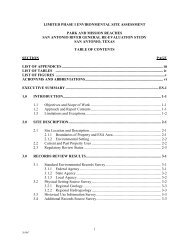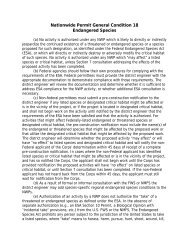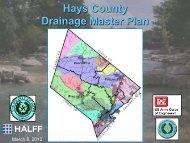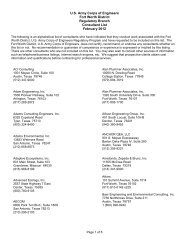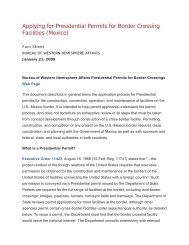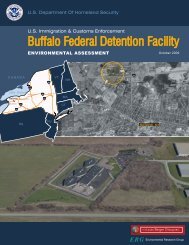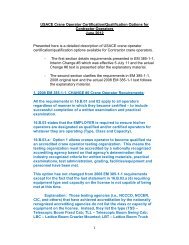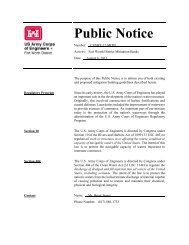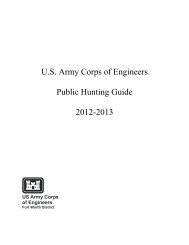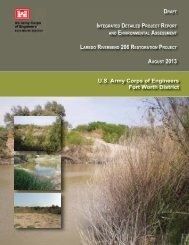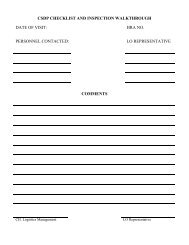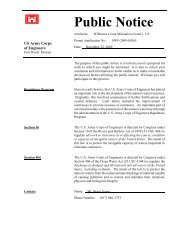environmental assessment us border patrol, tucson sector
environmental assessment us border patrol, tucson sector
environmental assessment us border patrol, tucson sector
You also want an ePaper? Increase the reach of your titles
YUMPU automatically turns print PDFs into web optimized ePapers that Google loves.
3-271234567891011121314151617181920212223242526272829303132333435363738394041424344454647part of Alternative 4. Th<strong>us</strong>, operational impacts on lesser long-nosed based from Alternative 4would be similar to those disc<strong>us</strong>sed for the Preferred Alternative.The current owner of the Alternative 4 site has constructed an earthen berm approximately 10feet high around the property that restricts surface water and potential eroded soil migration intoCottonwood Draw or Black Draw. All surface water at the Alternative 4 site evaporates orpercolates down to the groundwater table. Beca<strong>us</strong>e no runoff or associated sediments from theAlternative 4 site enter Cottonwood Draw or Black Draw, Alternative 4 would result in noadverse impacts on the beautiful shiner, Yaqui catfish, Yaqui chub, or their Critical Habitat.3.8 CULTURAL, HISTORICAL, AND ARCHAEOLOGICAL RESOURCES3.8.1 Affected EnvironmentThe National Historic Preservation Act (NHPA) establishes the Federal government’s policy toprovide leadership in the preservation of historic properties and to administer Federally owned orcontrolled historic properties in a spirit of stewardship. The NHPA established the AdvisoryCouncil on Historic Preservation (ACHP) to advocate full consideration of historic values inFederal decision making; review Federal programs and policies to promote effectiveness,coordination, and consistency with National preservation policies; and recommendadministrative and legislative improvements for protecting our Nation's heritage with duerecognition of other National needs and priorities. In addition, the NHPA also established theSHPO to administer the National historic preservation program on the state level and the TribalHistoric Preservation Officer (THPO) on tribal lands, where appropriate.The NHPA also establishes the NRHP. The NRHP is the Nation's official list of culturalresources worthy of preservation and protection. Properties listed in the NRHP include districts,sites, buildings, structures, and objects that are significant in United States history, architecture,archaeology, engineering, and culture. The National Park Service administers the NRHP.Section 106 of the NHPA requires a Federal agency to identify and assess the effects of itsactions on cultural resources. The Federal agency m<strong>us</strong>t consult with appropriate state and localofficials, Native American tribes, and members of the public and consider their views andconcerns about historic preservation issues when making final project decisions. The historicpreservation review process mandated by Section 106 is outlined in regulations issued by theACHP. Revised regulations, "Protection of Historic Properties” (36 CFR Part 800), becameeffective January 11, 2001.Several other important pieces of legislation include the Native American Graves Protection andRepatriation Act (NAGPRA), along with Executive Order (EO) 13007 and EO 13175.NAGPRA mandates the summarization, inventory, and repatriation of cultural items in thepossession of or control of a Federal agency to lineal descendants or to culturally affiliatedFederally recognized Native American tribes. NAGPRA also requires that certain procedures befollowed when there is an intentional excavation of or an inadvertent discovery of cultural items.EO 13007 was issued on May 24, 1996 in order to facilitate the implementation of the AmericanIndian Religio<strong>us</strong> Freedom Act of 1978. It specifically charges Federal agencies to: (1)accommodate, to the extent practical, American Indian access to and <strong>us</strong>e of sacred sites byreligio<strong>us</strong> practitioners; (2) avoid adversely affecting the physical integrity of sacred sites; and (3)Douglas FOB EADraftAug<strong>us</strong>t 2011



